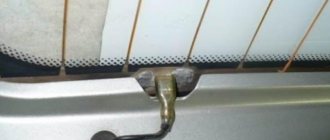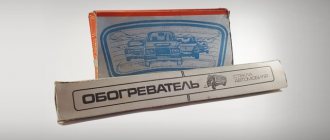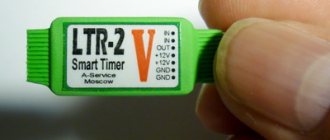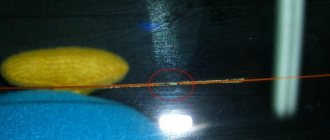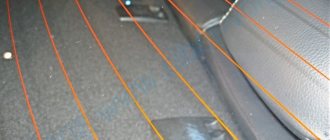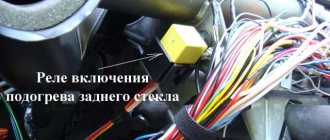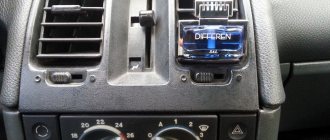Determining the location of the break
Finding a cliff is not difficult. The fog or frost around the thread will not disappear. That is why, in order to quickly find a damaged element, the threads are counted and then the damaged area is found. But sometimes the breaks are so insignificant that it is very difficult to notice them. Then you should use a voltmeter.
Due to the fact that one of the buses is connected to the car body, the negative wire of the multimeter is connected to the body. Next, the positive wire with the probe touches the first and second tires. On the first, the voltage is +12 V, and on the second – 0 V. If for some reason there is no access to the tires, then measurements can be taken where the threads come out from under the seal.
If there is voltage not only on the first, but also on the second bus, then look for bad contacts in the circuit connecting the heating system wires to ground.
Repair
There are several ways to repair this system. The most effective and fastest way is to use a rear window heating filament repair kit.
So how to make repairs? Everything is very simple:
- Using alcohol or solvent, clean the area of the glass where the thread breaks.
- We take the tape in our hands and stick it on both sides of the heating element. In this case, the distance between the tape should not differ from the thickness of the heating filament.
- Using a brush or syringe, apply conductive glue or paste (depending on which kit will be used). How to apply it? The glue should cover an entire part of the thread, 10 millimeters on each side.
- Remove the tape and wait for the glue to dry. According to the instructions, the composition dries in 24 hours.
- After a day, remove excess glue. This can be done with a sharp knife - kitchen or stationery. Be careful - a knife can easily damage the surface of the heating element.
- Wipe the glass with a soft and slightly damp cloth.
- We check the functionality of the element.
You can also use another product to repair the rear window heating filaments. This is “Elekont” of domestic production. The mass is applied to the place where the thread is broken. Apply glue so that it covers the entire part of the thread on each side. Once cured, the electrical heating system will work again.
Troubleshooting and repair
It is believed that it is quite simple to determine damage to the heating system, and every driver can cope with the given task. Before starting work, it is recommended to count the threads applied to the glass, so that later it will be easier to remember which one is damaged. There are times when the gap cannot be seen: it is so small that one of the devices should be used. This could be a voltmeter or multimeter. In any case, in order to repair the rear window heating threads, you need to carefully examine the surface and identify damage.
There are several effective troubleshooting methods:
- Visual diagnostic method - in damaged areas, when the heating is on, the glass does not warm up and remains fogged up.
- Using a voltmeter - with the heater on, one probe should be placed on the “ground” of the machine, and the second, wrapped in foil, should be placed in the center of the thread. It is necessary to monitor the voltage; its value should not exceed 5 V. If the device shows 0 or 12 V, then there is a gap in this place.
- Using an ohmmeter, the device is turned on in “kilo-ohm” mode and connected to the opposite terminals of the heater. You should moisten the cotton wool and run it along the thread. In the place where the arrow will twitch, there is a gap.
Determining whether the rear window heating is faulty
You can repair the heater using a variety of methods, for example, purchase a special kit for repairing the rear window heating filaments.
You can repair the system using a repair kit, conductive paste and traditional methods. The main difference between all options is the materials that are used during work.
Repair materials
By purchasing a repair kit, the driver has the opportunity to repair a heating filament up to 10 cm. Materials used in such kits:
- template with threads;
- thermally active polymer resin in a cylinder.
Materials for repairing heated rear window
Work is carried out strictly with the heating system turned off. Having determined the location of the damage, it is necessary to remove the protective film from the template and attach it to the location found. The polymer material is applied using a brush and, after drying, repeated several times. After completing the work, the stencil is removed and it is advisable not to turn on the heater for 24 hours.
In the case of using conductive paste, you may only need a hair dryer, which speeds up the drying of the material.
The materials that are used in “folk” methods of repairing a heater are paint (glue) and shavings, metal for soldering the damaged area. As a rule, the paint is selected in accordance with the color of the threads and combined with shavings, maintaining a 1:1 ratio. To work, you will need a stencil on which to apply the mixture (with the device turned on). The advantage of this repair method is that there is no need to wait 24 hours for drying. The driver can immediately drive after completing the work. Zinc chloride is suitable for soldering.
How to restore heat with glue
Quite often, drivers use conductive glue to repair the heated rear window. The material is mixed with shavings, which are extracted with a file or a copper-brass bar. The proportion is 1:1. The result is a soft dough consistency. A stencil is made using electrical tape or adhesive tape, and the prepared mixture is applied to the damaged area. After the procedure, there is no need to wait for the materials to dry and you can immediately hit the road.
Adhesive for repairing heated rear window
What to do with contacts, and other methods
If the contacts in the heating system of this element of the car are damaged, then it is best to use the soldering method. This method is the most reliable and will help you forget about this problem for a long time. Zinc chloride is perfect for the job. It is recommended to use solder with a minimum tin content. After finishing work, the glass should be rinsed well with water to remove any remaining chemicals.
How the system works
There is nothing supernatural in the very principle of operation of such a system. It is most often used to heat the rear window, but some car models implement heating of the front window, side glass and wiper locations when turned off.
The task of such a system is to create conditions on the surface of the glass that prevent frostbite or fogging. As you know, at temperatures below zero degrees Celsius, moisture freezes and ice forms. Therefore, to eliminate this phenomenon, it is enough to ensure the surface temperature is above zero degrees, and icing will not occur.
This is done quite simply - conductive strips are created on the glass, one end of which is connected to the vehicle’s on-board network, and the other through an appropriate control circuit to ground. When the heating is turned on, current begins to flow through such conductors; thanks to the generated heat, the glass is heated, which causes it to be freed from the formed ice.
Purchasing a new heated front window
The option is good if your car is equipped with a heated front window. You can simply purchase such glass and install it instead of the old one. This item will be original and of high quality.
If such equipment is not available, you can purchase Chinese non-original heated glass. This option is already a lottery, because it is not a fact that this frontal approach will work well.
Do not forget that this glass will have to be installed either independently or at a service center. It’s best to do it yourself, because purchasing new heated glass is an expensive purchase (the cost of such glass starts from 10,000 rubles).
Advantages: when buying the original, the highest quality option.
Disadvantages: high cost, risk of low-quality products when buying non-original ones.
Is the rear window heating working and how to check?
An initial conclusion about how well the rear window heating works or does not work can be made based on observing whether the glass is cleared of ice, and how evenly over the entire surface. If some of the heating filaments do not work, the result will be isolated areas covered with ice. In this case, you can think about restoring the heated rear window.
Often, the cause of heating failure can be not only the burnout of the heating element filaments. Among the possible reasons it is enough to mention:
- failure of contact in the terminals supplying voltage to the heater;
- failure of the switch or relay for turning on the heating system;
- The fuse in the heating circuit has blown.
As a rule, the most common defect will be broken heater filaments ; in all other cases, to restore heating, a simple external inspection is sufficient to identify a blown fuse or broken contact. In those cases when the rear window heating does not work due to breaks or microcracks in the heating filaments, it is quite problematic to detect the specific place where the circuit failure occurred.
The fact is that heating filaments are typically connected in parallel, so using a tester to find the location of the damage is useless; the connections will “ring” through parallel circuits. You need to look for damage visually using a magnifying glass, having previously determined which of the tracks is not working.
Operating principle and circuit of rear window heating
As mentioned above, heating can fail on any car, regardless of class, make and model. Moreover, all types of rear window heating are similar to each other. This means that heating the rear window of a VAZ will not differ much from a similar solution on any foreign car.
Simply put, thin threads of high-resistance metal are attached to the surface of the glass. When current passes through the filaments, heat is generated. The threads are applied so as to heat the glass evenly over the entire surface of the heated surface. This avoids cracking under conditions of strong temperature changes.
The general rear window heating circuit includes the following main elements:
- heating switch;
- heater fuse and relay;
- heating threads;
The principle of operation is that the voltage from the positive terminal of the battery is supplied through the ignition switch and fuses to the heating switch, as well as to the power contact of the relay. The negative terminal of the battery is connected to the car body, while one of the heating terminals is also powered to the body.
When the driver presses the heating button, voltage goes to the relay winding, then the relay is activated and its contacts close. After connecting the relay terminals, the electric current goes to the heater, passes through the heating filaments (connected in parallel), after which the current returns through the car body to the negative terminal of the battery.
How to restore heated rear window
When a damaged area of the heater filaments is found, it is worth thinking about how to restore the heating in full. Of course, you can restore it simply by replacing the glass, but this is a rather expensive operation, while there are several ways that allow you to eliminate the defect on your own, without too much effort. Before work, it is necessary to prepare the place where a break is detected and the heating filaments will be restored. To do this, the conductive path in the right place must be carefully cleaned of varnish and degreased with alcohol. A characteristic metallic sheen should be visible on the prepared area.
Track restoration can be done in the following ways:
- Using special conductive paste. It is applied to cold glass. When performing work, do not turn on the heating. The path, prepared as described above, at the site of damage should be limited on both sides with adhesive tape. The paste is then applied to the area that is not working. It hardens, as a rule, within 24 hours; you can check and use the heating after this day has passed.
- Using metal filings. This method allows you to restore functionality when there is no paste. For this, pre-prepared small iron filings are used. During the work process you will need transparent glue and a magnet. It must be secured over the area where the damage is detected, and then iron filings must be applied to this place. The magnetic field will force them to line up along the section of the track that is not working. Having leveled the sawdust and ensured electrical contact with the damaged area, they are covered with a layer of glue. You can check whether the repairs have been successfully completed and whether the heating is working in one and a half to two hours.
- Using shavings and paint, in this case shavings of non-ferrous metals are used. It is mixed with paint in such a way that a mass similar to plasticine is obtained. Using tape, a kind of stencil is formed around the damaged area. The heating is turned on, and the prepared mixture is applied to the desired area, and a characteristic hissing may occur at the point of contact, but after a while it disappears. This mixture hardens in twenty to thirty minutes; you can check and use the restored system after an hour.
There are some other methods that allow you to restore a non-working heating system, but those described are the simplest and most accessible.
Unfortunately, such methods are unlikely to be applicable to windshield restoration. It uses thinner conductive tracks and the repair area will appear quite rough, impairing the driver's visibility. For a car, heated rear window is not a luxury, but can significantly improve driving safety. And if it does not work, then with the help of fairly simple techniques you can restore its functionality. » alt=»»>
DIY rear window heating repair
It started getting colder outside and more and more often in the morning the first thing I have to do is press the heated rear window button. But HORROR, you turn on the heating and find that not all the threads are heating. What to do? Replacing glass is not a cheap pleasure; the only option is to do the repairs yourself. Commonly recommended repair methods
According to those who tried, the heating threads of the rear window leave much to be desired - the ineffectiveness of inexpensive conductive adhesives, and the high price of branded mixtures.
And then, on the Internet, I came across an interesting repair technology; reviews from those who tried it were more than enthusiastic:
Description of technology.
The reagents needed are copper sulfate - better known as copper sulfate (used in crop production and construction), and sulfuric acid - an electrolyte from a battery is quite suitable. From the tool - a piece of copper (preferably copper - not brass.
Several pieces of copper wire folded into a bundle, a tube or rod with a diameter of 6-10 mm and a strip of fabric 20-30 mm wide and about half a meter long are quite suitable. A strip of fabric half its width should be wound around the end of the rod - you should get something like a tassel. You need to put a thread bandage on top to prevent the fabric from unwinding.
Preparing the electrolyte - not to be confused with the acca electrolyte - is also not difficult. Add a couple of teaspoons of copper sulfate to half a glass of water and stir until dissolved. If it doesn’t dissolve completely, don’t worry, don’t pay attention. To the resulting solution you need to add 0.2-0.3% concentrated sulfuric acid or 0.5-1% battery electrolyte - this is about half a teaspoon of electrolyte per half glass.
Well, the actual process. Both terminals of the glass are connected to ground (if the glass is installed in a car and at least one heating thread is intact, nothing needs to be done), and the positive of the battery is connected to the tube with a rag.
We wet the positive electrode in the solution and begin to actively and continuously rub the area where the thread breaks for 3-5 minutes. A current passes through the solution, which transfers copper ions from the electrode to the heating filament. If the thread is slightly damaged, the gap is completely covered with copper; for large gaps, the copper-plated areas should be tinned with a non-overheated soldering iron and a jumper made of thin wire should be soldered.
There is no need to limit the current, because After a few seconds, the anode becomes passivated and limits the flow of current. We should not forget that the solution contains sulfuric acid - such a concentration is not dangerous for the skin, but after a week or two holes appear on the clothes (Therefore, I do not recommend carrying out the process without removing the glass, although this is quite possible.
- A couple more ways......
1st method:
– on fogged glass, turn on the heating and at the place of the break the glass quickly fogs up with a spot, while the entire thread with the break does not fog up.
2nd method:
– to detect a break in the rear window defogger conductor, turn on the ignition and turn on the rear window defroster. – connect one voltmeter probe to the ground of the car, and wrap the second probe in foil and move the foil along the heater conductor. – connect the voltmeter probe to the center of each conductor of the rear window defroster. If the voltmeter shows a voltage of about 5 V, then the heater conductor is working. If the voltmeter shows a voltage of 0 V or 12 V, then there is a break in the heater conductor.
– to locate the break point in the heater conductor, connect one voltmeter probe to the positive terminal of the heater, and move the second probe along the heater conductor from the negative terminal of the heater. The point at which the voltage indicated by the voltmeter drops from a few volts to zero is where the heater conductor breaks.
3rd method:
- ohmmeter, in kilo mode, or better yet mego. One probe clings to one terminal of the heater, the second probe to the other terminal of the heater. Take a piece of cotton wool soaked in distilled water and move it along the threads of the heater, monitor the readings of the kilometer, the megohmmeter at the point of break, the needle will twitch. – it is better to use an analog ohmmeter (with an arrow). – works if there is a break in one place...
Direct thread repair:
In all the methods listed below, you must first clean the conductive strip from varnish (preferably with a bent steel wire or paper clip) until a metallic sheen appears and degrease it. 1st method (conductive paste):
– You can restore a broken rear window heater conductor using conductive paste. – before starting repairs, turn off the rear window heating and allow time for the glass to cool. – Using caution, strip the heater conductor and rinse it with alcohol. – use adhesive tape to mark the area to be repaired. – Apply conductive paste approximately 20mm from each end of the damaged conductor. – After drying the electrically conductive paste for 24 hours, you can use the rear window defroster.
You can dry it at a high temperature, then you can use heating earlier. 2nd method (electrolytic coating):
– the reagents you need are copper sulfate – better known as copper sulfate (used in crop production and construction), and sulfuric acid – an electrolyte from a battery is quite suitable.
- from a tool - a piece of copper (preferably copper - not brass. Several pieces of copper wire folded into a bundle are quite suitable) tube or rod with a diameter of 6-10 mm and a strip of fabric 20-30 mm wide and about half a meter long.
– wrap a strip of fabric half its width around the end of the rod – you should get something like a tassel.
You need to put a thread bandage on top to prevent the fabric from unwinding.
– preparing the electrolyte – not to be confused with the battery electrolyte – is also not difficult. Pour a couple of teaspoons of copper sulfate into half a glass of water and stir until dissolved; if it doesn’t dissolve completely, don’t worry, don’t pay attention.
To the resulting pp you need to add 0.2-0.3% concentrated sulfuric acid or 0.5-1% battery electrolyte - this is about half a teaspoon of electrolyte for this half glass. – the process itself.
Both terminals of the glass are connected to ground (if the glass is installed in a car and at least one heating thread is intact, nothing needs to be done), and the positive of the battery is connected to the tube with a rag. We wet the positive electrode in the solution and begin to actively and continuously rub the area where the thread broke for 3-5 minutes.
A current passes through the solution, which transfers copper ions from the electrode to the heating filament. In case of slight damage to the thread, the gap is completely covered with copper; in case of large gaps, the copper-plated areas should be tinned with a non-overheated soldering iron and a jumper made of thin wire should be soldered.
There is no need to limit the current, because After a few seconds, the anode becomes passivated and limits the flow of current. Don't forget that the solution contains sulfuric acid!
3rd method (paint with shavings): – take a copper-brass bar (graphite will also do) and start making shavings with a small file. – paint (can be red, to match the color of the threads) is mixed with shavings, the proportion is approximately 50/50. You should get a dough-like mixture. – the heating is turned on and paint is applied to the thread, having first made a stencil from electrical tape or adhesive tape. During the process of applying the paint, a hissing sound appeared from the point of contact, then it disappeared, but the thread warmed up. - done. Literally after a minute the composition hardens.
4th method (magnet and glue): – prepare very fine iron filings, a small magnet (from a speaker) and transparent glue (type BF-2) or nitro varnish. – apply a magnet from the outside above the break point, then sprinkle sawdust on the side of the conductor, gently moving the magnet to achieve electrical contact at the break point (this will be noticeable by heating the strip - unless of course the break is in one place, otherwise more magnets will be needed). – apply a drop of glue to the sawdust with a small squirrel brush and let the glue (varnish) dry. – then remove the magnet and use a blade to remove excess sawdust. You can reapply another layer of glue (varnish). - enough for several years.
5th method (special adhesives): – special adhesives for restoring heating filaments, there are also Russian-made ones – reviews are contradictory, some like them, others don’t – instructions for use are included with the glue – it is recommended to add a little iodine to the glue. In this case, the glue turns out red and matches the color of the other threads
6th method (soldering): – damaged areas can be soldered with soft low-tin solder POS-18 or POSS-4-6, using zinc chloride as a flux. If a long section is damaged, it is better to solder a thin copper or silver core from the wire.
7th method (sawdust and glue): – silver filings (for example, an alloy ground off with a file from the contact of an unusable power relay) should be poured into the fold of a piece of paper, and a drop of nitro glue should be added there. Quickly roll a cylinder 2…3 mm long and 1 mm in diameter with the tip of a knife and apply it to the damaged area. Then crush it to tightly compress the sawdust and remove excess.
To implement this idea, I used the 2nd method - electrolytic coating. Here was the gap:
it was visible to the naked eye, but just in case, I rang this place with a tester... Then I made a device with which copper ions will be applied:
it is done very simply... I took 3 copper wires from a 2.5mm copper wire, soldered them together, put a heat shrink tube on them, stripped the copper, wrapped a rag about 3 cm wide, secured it all with zip ties....
on the other hand, I soldered a plug-in contact so that this device could be connected instead of heating. Next, copper sulfate began to play, fortunately there were old supplies and I took a little acid from the battery with a syringe... (Copper sulfate can be bought at a store that sells fertilizers). The result was this liquid:
Then everything is according to the instructions.... I lowered the electrode into the glass, disconnected the positive wire from the glass heating, connected a homemade electrode to it, turned on the ignition and the heating button - thus “+” appeared on the electrode...
There is a “-” sign on the heating strips. I just moved over the place where there was a gap and saw how a copper deposit formed... I note that this method is most effective for small scratches... To be on the safe side, I also soldered this place, fortunately after such a copper plating procedure everything is soldered with a bang! In the end, everything worked out and everything works!
.
